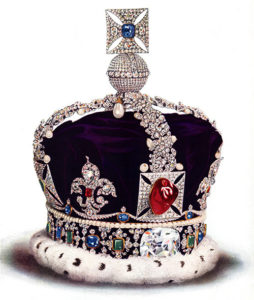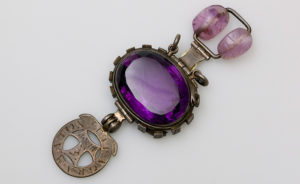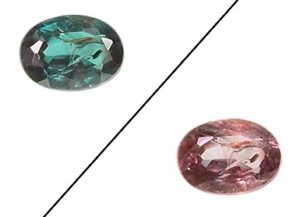Famously Misidentified Gemstones
Gemstones catch the eye of Rockhounds for their unique shapes and colors. Yet, some gemstones are nearly indistinguishable, even to the trained eye. Until the introduction of chemical properties, classifying rare stones was a challenging process that relied heavily on observing physical properties.
Qualities like color, hardness, streak, and diaphaneity were some of the properties that were readily observable to merchants, miners, and jewelers. With modern gemology, the chemical composition and crystal structures of a stone are taken into account. While these properties help us understand the differences between specimens, it has also uncovered identification errors made of famous gemstones.
Black Prince’s Ruby

The gemstone at the front of George V’s Imperial State Crown. G. Younghusband; C. Davenport (1919). The Crown Jewels of England. London: Cassell & Co. p. 6.
The Black Prince’s Ruby is an egg sized gemstone that was originally owned by the Moorish Prince of Granada, Spain in the 14th century. The gemstone was received by the Prince of Wales in 1367 as payment for a victory in battle and later given to King Henry V of England in 1415.[1]
The massive gemstone soon became legendary when it saved King Henry’s life from an axe blow to the head during a battle with French Prince Duc d’Alencon.[2] The Black Prince’s Ruby has since adorned the Imperial State Crown of the United Kingdom, having been passed down to numerous British kings and queens.
In the 16th century, it was found that the Black Prince’s Ruby was not a Ruby after all, but a Spinel instead.[3] The Spinel earned a reputation as “The Great Imposter” by English jewelers as its physical properties are nearly indistinguishable to that of the Ruby.
The Delhi Purple Sapphire

The Dehli Purple sapphire – revealed later to be an amethyst. Source: Natural History Museum (London)
The Delhi Purple Sapphire is a large gemstone set in a silver ring with alchemic and astrological signs decorating its band. The Sapphire was thought to be a “cursed gemstone” for its curious history of unfortunate events befalling its owners.
Records show that The Sapphire started its journey in India where it was stolen from the Temple of Indra in 1855.[4] The Sapphire eventually found its way into the hands of Edward Heron-Allen, an expert in paleontology and author of many archaeology books, who would immediately find himself in the way of bad luck.[5]
Incidents from bad investments to friends suffering bodily harm convinced Heron-Allen to distance himself from the stone. When Heron-Allen tried to get rid of the gemstone by throwing it into the Regent’s Canal, it was mysteriously returned to him a few months later by a local jeweler.
In January 1944, the Heron-Allen family gave the Delhi Purple Sapphire to London’s Natural History Museum where the stone was found to be an Amethyst.[6] Curators at the Natural History Museum believe these claims were started by Edward Heron-Allen to give credibility to the Amethyst.
Alexandrite

Alexandrite exhibits amazing color-change properties. This is the same stone under different lighting.
Russia became a major source of Emerald gemstone in the 1830s when deposits were found along the Tokovaya River.[7] The discovery then attracted miners to the river and the nearby Ural Mountains where reports of sizable Emerald gemstones were also found.
The Ural Mountains supplied the area with many large gemstones, including a notable discovery by French scientist Nils Gustaf Nordensköld. In 1834, Nordensköld was inspecting Emeralds found in the Ural Mountains when he found some of the stones had a chromium bearing, pleochronic variety of chrysoberyl.[8]
This discovery gave birth to a new gem quality stone, the Alexandrite, whose color would change from a deep emerald green in daylight and red in nightfall. Alexandrite, having been discovered in Russia and found to be one of the rarest colored gemstones, then became the official gemstone of Imperial Russia’s Tsardom.[9]
Despite the misidentification of these gemstones, their rich history and lore is what truly makes them some of the world’s most valued gemstones. After all, beauty is in the eye of the beholder.
Have you seen our expansive collection of rare rocks and minerals? We’ve recently updated our galleries with many impressive specimens from around the world. You can find our latest collections here.
Also, don’t miss our listings for our rare rock and mineral shows. We’d love to meet with you and talk about the specimens in our collections!
[1] Byashley F. “Spinel”. Sothesbys. http://www.sothebys.com/en/news-video/blogs/all-blogs/masterpieces-in-the-making/2015/11/spinel-gemstone-the-great-imposter.html
[2] Richard H. “The Black Prince’s Ruby”. Ruby Sapphire. http://www.ruby-sapphire.com/black-princes-ruby.htm
[3] “Spinel”. International Colored Gemstone Association. http://www.gemstone.org/index.php?option=com_content&view=article&id=124:sapphire&catid=1:gem-by-gem&Itemid=14
[4] Amy F. “Specimen of the Month #1: The Cursed Amethyst”. Natural History Museum. http://www.nhm.ac.uk/natureplus/blogs/behind-the-scenes/2013/11/21/specimen-of-the-month-1-the-cursed-amethyst?fromGateway=true
[5] John S, Haunting Museums (London: Macmillian, 2009), 206.
[6] Amy F. “Specimen of the Month #1: The Cursed Amethyst”. Natural History Museum. http://www.nhm.ac.uk/natureplus/blogs/behind-the-scenes/2013/11/21/specimen-of-the-month-1-the-cursed-amethyst?fromGateway=true
[7] Richard H, John K, and Waren B. “Emerald & Alexandrite from Russia”. Lotus Gemology. http://www.lotusgemology.com/index.php/library/articles/298-emeralds-from-russia-a-closer-look
[8] George F, The Curious Lore of Precious Stones (Philadelphia: J. B. Lippincott Company, 1913) 55-56.
[9] Ibid.